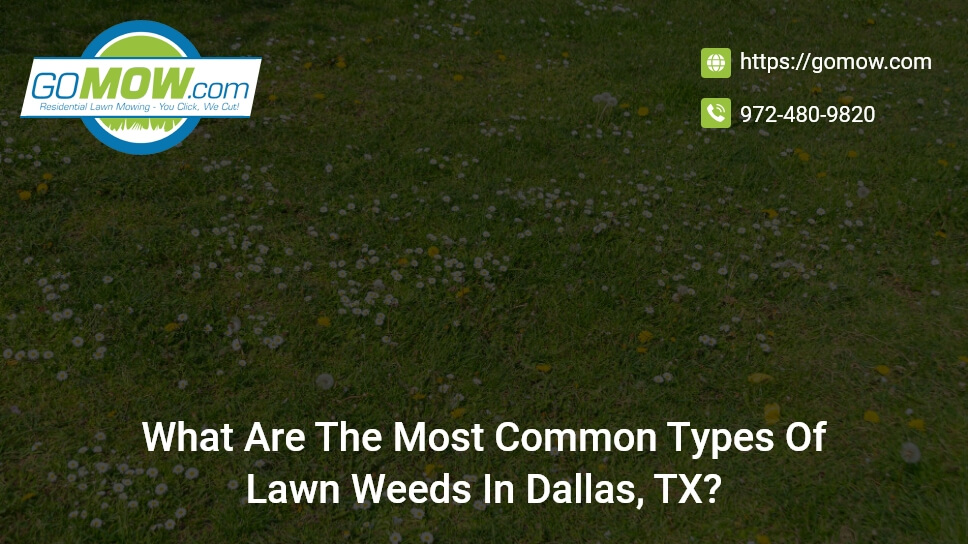What Are The Most Common Types Of Lawn Weeds In Dallas, TX?

What Are Weeds?
Plants that grow in unwanted places are called weeds.This is the simplest definition of weeds; any plant can be a weed as long as it’s growing where it isn’t needed. Common lawn weeds can be any plant growing where it is not wanted. In the post we have discussed the types of weeds in grass lawns.
A number of typical lawn weeds can emerge and pose a threat to your grass’s health and aesthetic appeal. The following are some of the more common ones you can find on your lawn. We have also included how to take them out with or without the help of a yard service in Dallas:
-
Dandelions
Though beautiful to look at, dandelions are a nightmare to get rid of when they sprout on your lawn. They are quite easy to detect due to their unique leaves and blooms, but removing them is a different ball game entirely. Their beautiful yellow springtime blooms may be lovely, but their parachute-shaped seeds are tough to eliminate because they spread quickly and encourage the growth of new plants.
Solution – Broadleaf herbicides are the most efficient way to eradicate dandelions because of their deep taproot, which makes removal difficult.
-
White Clover aka Trifoloum repens
White clover is a fast-spreading broadleaf perennial that thrives in nutrient-poor soil. Recognizable by its summer-blooming white flower heads, it’s a persistent plant that requires attention. To control white clover, use a selective iron-based herbicide or manually remove it, ensuring the root system is extracted.
Be aware that even with these efforts, battling white clover may persist due to resilient seeds. Optimal for hardiness zones 3-9, this clover attracts bees and requires corrective measures for nitrogen levels in the soil.
Solution – The most effective eradication method is the use of an iron-based herbicide.
-
Chickweed aka Stellaria media
Chickweed, a low-growing annual weed with star-shaped flowers, thrives in winter. Its resilient nature makes it withstand mowing well. Control it by applying a pre-emergent herbicide in early spring or by hand-pulling, ensuring to extract shallow roots before dense coverage.
Chickens enjoy feasting on chickweed, possibly explaining its name. You will notice that chickweed leaves fold at night or before rain. This broadleaf plant is found in hardiness zones 4-11, prefers most soils, and poses minimal danger as it is edible. Lawn mowing service Dallas can easily tackle this type of weed once it’s noticed early.
Solution – The most effective control method is a pre-emergent broadleaf herbicide.
-
Bull Thistle aka Cirsium vulgare
Bull thistle, a challenging weed in turf, is recognized for its purple fringed flowers and rapid multiplication. With approximately 5,000 seeds per season, controlling thistle requires a persistent strategy. To effectively remove bull thistle, use a post-emergent herbicide during early to late spring, focusing on its flowering stage.
Consistent efforts may be needed, and manual removal should include extracting the entire taproot and securing the seed head to prevent seed dispersal. However, the success of your efforts may still be hindered if neighbors do not adopt similar seed-limiting approaches.
Solution – Post-emergent Broadleaf Herbicides
-
Oxalis aka Oxalis stricta
Oxalis, or yellow wood sorrel, is recognized by its yellow, heart-shaped flowers that bloom in warmer months. Despite its clover-like appearance, this sour-tasting weed is often unwelcome in yards. Its presence may indicate issues with your turf, such as pests, thinning, disease, or incorrect pH levels.
To tackle oxalis, consider using pre-emergent herbicides before germination or post-emergent herbicides after growth. Contact lawn maintenance in Dallas to take care of this weed as soon as you notice it. Mulching around your garden or using landscape barriers can also help keep oxalis in check if manual weeding is not an option due to time constraints.
Solution – Pre-emergent and Post-emergent herbicides
-
Crab Grass aka Digitaria
Crabgrass is one of the most common weed types you will find on many Texas lawns. It is named for its unappealing appearance. Its distinctive look makes it easy to spot among your turf which is important for early detection and removal. The most effective method to eliminate crabgrass is to use a selective pre-emergent herbicide, or crabgrass preventer, in the spring to halt its growth. Although crabgrass dies with the first fall frost, it leaves behind seeds that may attempt a comeback in the following spring.
Solution – Pre-emergent Herbicides
-
Quackgrass aka Elymus repens
Quackgrass is a tough blue-green perennial with wheat-like auricles. Its dense clumps spread through underground rhizomes, making it a serious challenge for lawn owners in Texas. It thrives at lower temperatures and is most common in the Northern United States throughout the spring and fall seasons.
Eliminating quackgrass requires consistent effort as it is difficult to get rid of without persistence. It is possible to pull it by hand, but make sure that all root parts are removed. Although spot-treating with a non-selective post-emergent herbicide is effective, it must be done with absolute care. Smothering with black landscaping plastic can reduce its growth. Consider this as a final option if everything fails.
Solution – Pull completely by hand, Use post-emergent herbicides or Smother
-
Henbit aka Lamium amplexicaule
This is an annual broadleaf weed displaying a distinctive growth pattern. Its germination occurs during the fall, and it persists throughout the cool season and into spring. Characterized by notched, circular leaves affixed to delicate stems, Henbit is quite stubborn to tackle which is why you need an experienced yard service in Dallas to tackle it.
After its growth phase, Henbit blossoms into pink-purple flowers during the spring. Subsequently, it disperses seeds across the surrounding yard, contributing to its spread and propagation.
Solution – Tackle with pre-emergent and post-emergent weed control agents
Best Weed Control Methods
There are several weed control measures that are effective in tackling common lawn weeds. Some of the best options are as follows:
-
Pulling by hand
Hand removal is effective if done correctly. Ensure that all parts of the weed plant are removed during pulling for efficacy through this method.
-
Pre-emergent herbicide
The pre-emergent herbicide is precisely that: a barrier against weed seed invasion. Acting before the seeds sprout ensures a preemptive strike, protecting your garden from the start.
-
Post-emergent Herbicide
When weeds have already made their appearance, the post-emergent herbicide – the growth terminator – comes into play. It swoops in after weeds have sprouted to provide a clean, spotless landscape.
-
Precision Broadleaf Herbicide
Some weeds have the broadest leaves, making them easy to identify. Enter the broadleaf herbicide, which specializes in killing these particular weeds. At its finest, precision weed warfare!
-
Iron-based Herbicide
We introduce an iron-based herbicide for a more selective strategy. This weed control agent will destroy the weed plant without affecting other nearby plants.
-
Smothering
Cut off air, water, and nutrients through smothering to kill the weed plant and its spores. Usually, smothering is done with a large plastic cover or tarp designed for this purpose.
Final Words
GOMOW Lawn Care Service offers a FREE QUOTE that comes with our lawn mowing service.
If you’re spending too much time on lawn maintenance in Dallas, TX, you can simply delegate this task to a yard service. We are here to take care of your lawn mowing needs.
Contact us through the link below to get started with affordable lawn mowing in Dallas, TX.
Your free quote is waiting >> https://gomow.com/get-quote/.



